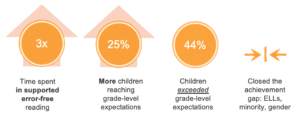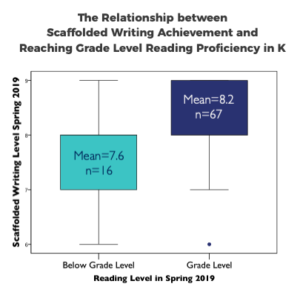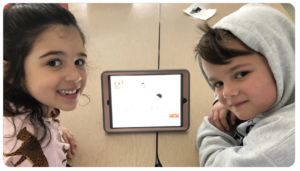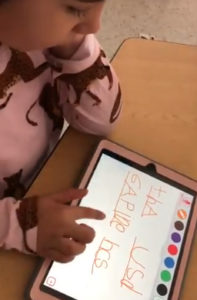PowerTools Literacy Solution
Our integrated PowerTools Literacy Solution leverages cutting edge technology infused with the latest reading science to amplify Tools’ impact on children’s early reading outcomes.
Doing Technology Right
 PowerTools is not “just another app.” In Tools, we carefully and intentionally design our technology to truly amplify children’s supported reading practice, and support teachers in tracking and understanding each child’s reading progress so they can attend to each child’s individual needs.
PowerTools is not “just another app.” In Tools, we carefully and intentionally design our technology to truly amplify children’s supported reading practice, and support teachers in tracking and understanding each child’s reading progress so they can attend to each child’s individual needs.
By doing technology right, we can leverage the advantages that technology offers to reverse the ‘sticky’ trends that contribute to the current achievement gap. For instance, today the beginner reader spends only 6 minutes per day reading connected text; children are grouped by their reading ability, negatively impacting psychosocial behaviour; and teachers are stretched in their capacity to individualize instruction for each child in classrooms.
With PowerTools, children are tripling the time they spend on supported reading. PowerTools enables social reading where children learn to read with partners at the same and different levels, so they can read the same books together written with multi-level text. With our powerful Data Analytics dashboard, teachers can access live, actionable data that helps them identify exactly what the child needs at that particular stage of learning to propel the child on their reading journey.
Children can use PowerTools in school and at home, enabling teachers access to both in-school and at-home data. This integrated approach ensures continuity across settings, so that children have the same supported approach to learning to read and access to individualized scaffolding. Furthermore, parents learn how to support their child’s reading by watching their child’s interactions with the app.
By infusing the latest reading science in every step of our technology development, the PowerTools Literacy Solution changes the reading paradigm.
“I think the connection of the PowerTools books with our background units of study is such an essential part of its success. My children are enthralled, humored, and focused because the material is so well presented and so meaningful. I love hearing their comments as they are so knowledgeable, and their giggles at the incorrect comprehension choices. They also love the variety of illustration…..photos, clay figures, drawings.”
— PowerTools Teacher
“Two years in a row, I have noticed that my students read longer on PowerTools than with Raz Kids or regular books.
— PowerTools Teacher
The 5 Components of PowerTools
The PowerTools Literacy Solution integrates five components that reinforce literacy learning in a socially inclusive way:
 Interactive Read Alouds: are eBooks, aligned with Next Generation Science Standards, introducing science concepts connected to Magic Tree House themes.
Interactive Read Alouds: are eBooks, aligned with Next Generation Science Standards, introducing science concepts connected to Magic Tree House themes.- Science Minds: a series of hands-on science activities children complete with a partner to apply and deepen their understanding of concepts learned.
- PowerTools Reading App: is an iPad application (coming to additional platforms in Winter 2020) that embeds executive functions and merges science and literacy to augment the time children engage in supported reading practice in a motivating way. Each book is written at different levels of text complexity, but has the same rich, science-based content, so all children to access the same content as they become stronger readers together. ▶︎ Watch the PowerTools overview video here.
- DWA (Developmental Writing Assessment) App: is an iPad application for PreK and K that records children’s writing development and enables teachers to efficiently track and assess children’s writing over time.
- Analytics Data Portal: is embedded in both the PowerTools Reading for K and DWA apps for PreK and K. The dashboard empowers teachers with live, actionable data that helps teachers engage and differentiate instruction for all learners.
Breakthrough Results
PowerTools Reading App
Within four months, pilot data from a classroom showed that children who used PowerTools tripled the amount of time they engaged in supported, scaffolded reading practice, and had increased levels of motivation. PowerTools enabled 25% more children to reach grade-level reading proficiency, and had 44% of children exceed grade-level expectations. The achievement gap for dual-language learner, girls and boys, and at-risk children was closed.

DWA (Developmental Writing Assessment) App

Scaffolded Writing is tightly linked to reading development and is a powerful foundation for early reading, as it embeds all of the foundational literacy sub-skills needed for reading success.
In a Tools pilot study in one urban school, we found that children who reached higher levels of Scaffolded Writing by the end of the year were more likely to reach grade level proficiency in reading.
Case Study
Making Reading Enjoyable

Judy Suchecki has been a Kindergarten teacher for 44 years, and an avid Tools user for ten of those. So when her elementary school in Orleans, MA was given the chance to beta test the new PowerTools application, she jumped at the chance.
Using school-issued iPads, Judy’s students began incorporating PowerTools on a daily basis to reinforce key themes from their Tools of the Mind classroom. From laughing at the silly comprehension questions to choosing to read during free time, the children were thoroughly engaged and made crucial connections to the stories. As a result, they spent more time reading.
“PowerTools was fabulous, and the children loved it! By the time the trial was done, I could not believe how effortlessly they could read.”
Judy Suchecki, Kindergarten Teacher
Test scores in the classroom confirmed what Judy experienced. While using the Tools methodology alone had demonstrated significant gains in children’s reading levels over the years, the results with PowerTools were even better. Students who started the year not knowing letters and sounds were reading by the spring. Those who came in knowing some letters and sounds scored at a middle first grade level. And those who had a good grasp of letters and sounds initially achieved reading levels at the middle of second grade by year’s end.
